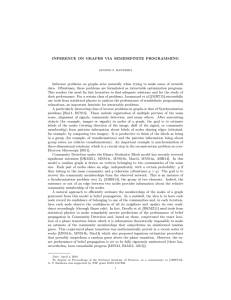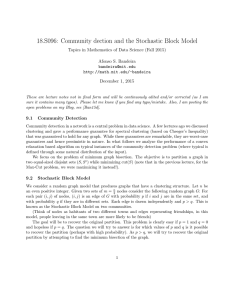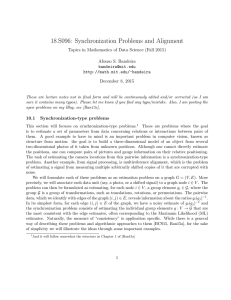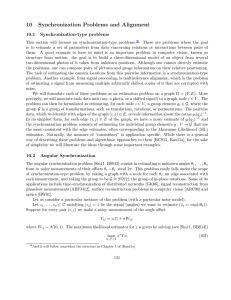EFFICIENT ALGORITHM FOR EXACT RECOVERY OF VERTEX VARIABLES FROM EDGE MEASUREMENTS
advertisement
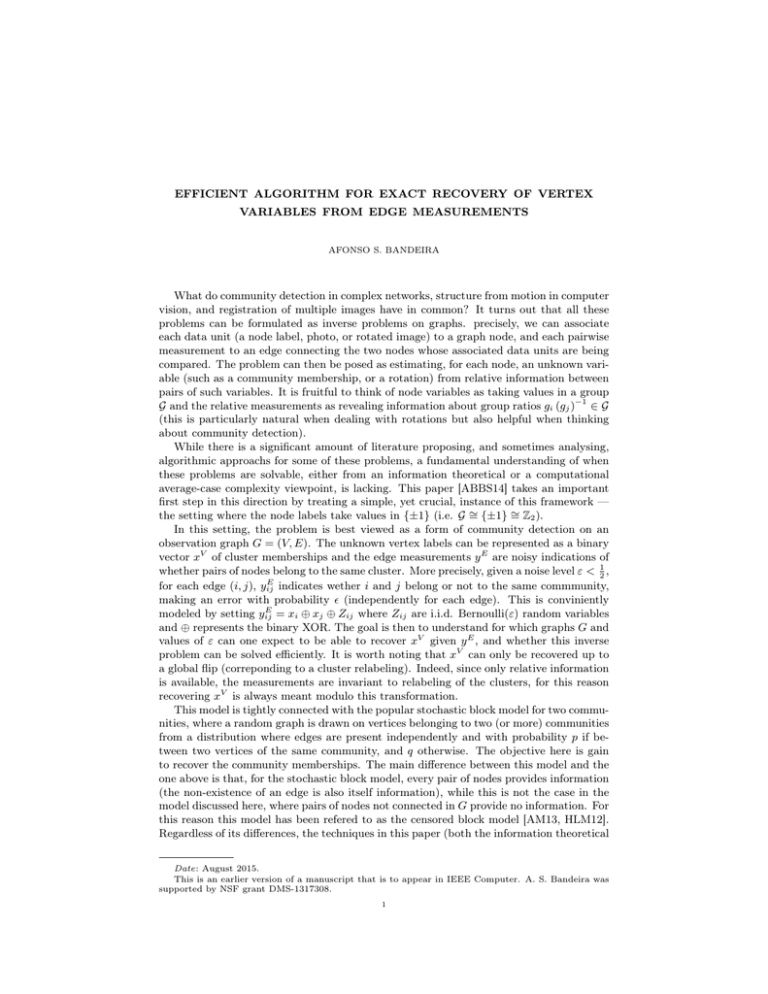
EFFICIENT ALGORITHM FOR EXACT RECOVERY OF VERTEX
VARIABLES FROM EDGE MEASUREMENTS
AFONSO S. BANDEIRA
What do community detection in complex networks, structure from motion in computer
vision, and registration of multiple images have in common? It turns out that all these
problems can be formulated as inverse problems on graphs. precisely, we can associate
each data unit (a node label, photo, or rotated image) to a graph node, and each pairwise
measurement to an edge connecting the two nodes whose associated data units are being
compared. The problem can then be posed as estimating, for each node, an unknown variable (such as a community membership, or a rotation) from relative information between
pairs of such variables. It is fruitful to think of node variables as taking values in a group
G and the relative measurements as revealing information about group ratios gi (gj )−1 ∈ G
(this is particularly natural when dealing with rotations but also helpful when thinking
about community detection).
While there is a significant amount of literature proposing, and sometimes analysing,
algorithmic approachs for some of these problems, a fundamental understanding of when
these problems are solvable, either from an information theoretical or a computational
average-case complexity viewpoint, is lacking. This paper [ABBS14] takes an important
first step in this direction by treating a simple, yet crucial, instance of this framework —
the setting where the node labels take values in {±1} (i.e. G ∼
= {±1} ∼
= Z2 ).
In this setting, the problem is best viewed as a form of community detection on an
observation graph G = (V, E). The unknown vertex labels can be represented as a binary
vector xV of cluster memberships and the edge measurements y E are noisy indications of
whether pairs of nodes belong to the same cluster. More precisely, given a noise level ε < 12 ,
E
indicates wether i and j belong or not to the same commmunity,
for each edge (i, j), yij
making an error with probability (independently for each edge). This is conviniently
E
modeled by setting yij
= xi ⊕ xj ⊕ Zij where Zij are i.i.d. Bernoulli(ε) random variables
and ⊕ represents the binary XOR. The goal is then to understand for which graphs G and
values of ε can one expect to be able to recover xV given y E , and whether this inverse
problem can be solved efficiently. It is worth noting that xV can only be recovered up to
a global flip (correponding to a cluster relabeling). Indeed, since only relative information
is available, the measurements are invariant to relabeling of the clusters, for this reason
recovering xV is always meant modulo this transformation.
This model is tightly connected with the popular stochastic block model for two communities, where a random graph is drawn on vertices belonging to two (or more) communities
from a distribution where edges are present independently and with probability p if between two vertices of the same community, and q otherwise. The objective here is gain
to recover the community memberships. The main difference between this model and the
one above is that, for the stochastic block model, every pair of nodes provides information
(the non-existence of an edge is also itself information), while this is not the case in the
model discussed here, where pairs of nodes not connected in G provide no information. For
this reason this model has been refered to as the censored block model [AM13, HLM12].
Regardless of its differences, the techniques in this paper (both the information theoretical
Date: August 2015.
This is an earlier version of a manuscript that is to appear in IEEE Computer. A. S. Bandeira was
supported by NSF grant DMS-1317308.
1
2
BANDEIRA
limits and the algorithmic part) have now been successfully adapted to the setting of the
stochastic block model [ABH14].
One of the main contributions of the paper is to show that, if the observation graph
is taken to be an Erdős-Rényi graph 1 with edge probability p (meaning that the average
degree is roughly np), then exact recovery of xV is possible, with high probabiltiy, if and
only if
α := np/ log(n) > 2/(1 − 2ε)2 + o 2/(1 − 2ε)2 .
It is worth noting that, if α < 1, the observation graph is known to contain isolated nodes
with high probability, rendering recovery impossible even in a noiseless setting, as there
would be nodes for which no information is available. The main tool behind establishing
this result are concentration of measure inequalities.
On the algorithmic side, the quadratic nature of the maximum likelihood estimator
for xV can be leveraged to design a semidefinite programming relaxation based algorithm
for this problem [Sin11]. Duality and estimates on spectral norms of certain random
matrices [Tro12, Tro15] are used to show that this efficient algorithmic approach exactly
recovers xV , with high probability, at essentially a factor of 2 away from the information
theoretical limit. Remarkably, this gap has since been closed by making use of sharper
estimates on the spectrum of random matrices [Ban15, HWX15].
It is also worth pointing out that the techniques used to both understand the information theoretical limits and establish the efficacy of the semidefinite relaxation approach
have also since been adapted to community detection with more than two communities [AS15, HWX15, ABKK15, PW15]. Also, while the problem considered here is to
exactly recover xV , recent work [CRV15, SKLZ15] analyzed the problem of partially recover xV solving one of the open problems posed in the paper.
References
[ABBS14] E. Abbe, A. S. Bandeira, A. Bracher, and A. Singer, Decoding binary node labels from
censored edge measurements: Phase transition and efficient recovery, Network Science
and Engineering, IEEE Transactions on 1 (2014), no. 1, 10–22.
[ABH14] E. Abbe, A. S. Bandeira, and G. Hall, Exact recovery in the stochastic block model, Available
online at arXiv:1405.3267 [cs.SI] (2014).
[ABKK15] N. Agarwal, A. S. Bandeira, K. Koiliaris, and A. Kolla, Multisection in the stochastic block
model using semidefinite programming, Available online at arXiv:1507.02323 [cs.DS] (2015).
[AM13]
E. Abbe and A. Montanari, Conditional random fields, planted constraint satisfaction and
entropy concentration, Proc. of RANDOM (Berkeley), August 2013, pp. 332–346.
[AS15]
E. Abbe and C. Sandon, Community detection in general stochastic block models: fundamental limits and efficient recovery algorithms, to appear in FOCS 2015, also available
online at arXiv:1503.00609 [math.PR] (2015).
[Ban15]
A. S. Bandeira, Random Laplacian matrices and convex relaxations, Available online at
arXiv:1504.03987 [math.PR] (2015).
[CRV15]
P. Chin, A. Rao, and V. Vu, Stochastic block model and community detection in the
sparse graphs: A spectral algorithm with optimal rate of recovery, Available online at
arXiv:1501.05021 [cs.DS] (2015).
[HLM12] S. Heimlicher, M. Lelarge, and L. Massoulié, Community detection in the labelled stochastic
block model, arXiv:1209.2910 (2012).
[HWX15] B. Hajek, Y. Wu, and J. Xu, Achieving exact cluster recovery threshold via semidefinite
programming: Extensions, Available online at arXiv:1502.07738 (2015).
[PW15]
W. Perry and A. S. Wein, A semidefinite program for unbalanced multisection in the stochastic block model, Available online at arXiv:1507.05605 [cs.DS] (2015).
[Sin11]
A. Singer, Angular synchronization by eigenvectors and semidefinite programming, Appl.
Comput. Harmon. Anal. 30 (2011), no. 1, 20 – 36.
[SKLZ15] A. Saade, F. Krzakala, M. Lelarge, and L. Zdeborová, Spectral detection in the censored
block model, Available online at arXiv:1502.00163 (2015).
[Tro12]
J. A. Tropp, User-friendly tail bounds for sums of random matrices, Foundations of Computational Mathematics 12 (2012), no. 4, 389–434.
[Tro15]
, An introduction to matrix concentration inequalities, Found. Trends Mach. Learning 8 (2015), no. 1–2, 1–230.
(Bandeira) Department of Mathematics, Massachusetts Institute of Technology, Cambridge,
Masachusetts 02142, USA (bandeira@mit.edu).
1An Erdős-Rényi graph with edge probability p is a random graph where each pair of nodes is
connected by an edge, independently and with probability p
